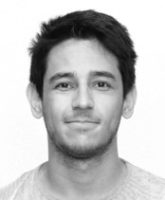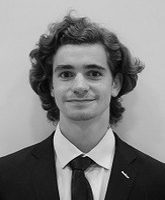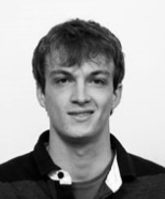Interns at Kelda
Bivrost Development Operations Smart Identification 10/09/2018 – 04/02/2019 João works on an AI component used for identification of field operations. By using machine learning models, this automatically finds and classifies common operations during the drilling process. The result is an intelligent analysis of data available in Bivrost and enhanced operation reports. It implies the extraction of data from several Mongo and Influx databases, the creation of data-driven models using Weka and Python, and the deployment of those models in a React-based project (Javascript). Studies: Digital Engineering of Complex Systems – Mines ParisTech (FR) Mechatronics Engineering – USP (BR)
Bivrost Cloud Portal Development 04/06/2018 – 30/11/2018 Louis works on the development of the Bivrost, the Kelda’s web platform used to plot and manage operational data. Louis contributes at each part of the development process according to the goals of the team. This involves the development of Meteor/React and Flask applications, linked to MongoDB and Influx databases, with the use of Docker to set up isolated environments. Studies: Management of IT systems – Mines ParisTech (FR)
Bivrost Cloud Portal Development 04/06/2018 – 30/11/2018 Thomas works on the development of the Bivrost. This tool allows all its users to upload, plot and download operational data through a simple internet access. Thomas mainly focuses on the front-end and the user experience of the Bivrost. It implies the development and the deployment of a client/server architecture in Javascript, the use of React and Redux with multiple Mongo and Influx databases. Studies: Engineering Design & Management – Mines ParisTech (FR)
Bivrost Development Real-Time Data Uploads 04/06/2018 – 28/09/2018 Jean-Baptiste works on the development of the Bivrost, the web platform used to plot and manage operational data. He mainly focuses on real-time data uploads, by setting up a new software architecture aimed at improving their performance, reliability and scalability. For that, Jean Baptiste works with Celery tasks queues, Docker, Python, as well as Mongo and Influx databases. Studies: Computer Science & Control Engineering – Mines ParisTech (FR)
Extension of the Leidar® MPD Design Model 04/04/2018 – 28/09/2018 Louis is working on an extension of the hydraulics model used by Kelda for the Leidar® Control System. This extension is based on a more accurate description of the choke, at the output of the well. The first step was to design this extension, then design new observers based on it. Finally, alternative controllers can be tested using these new models. All of this is designed using Matlab/Simulink. Studies: Computer Science & Control Engineering – Mines ParisTech (FR)
First Design of Influx Management Enveloppe (IME) 01/02/2018 – 31/07/2018 Guillaume is developing the first version of Influx Management Enveloppe, a decision-making tool when a kick occurs. This tool helps its users to choose between well or pressure controls. It was first developed on Matlab with an HMI, and now on Python connected with another HMI on the web. Studies: Geosciences – Mines ParisTech (FR)
Bivrost Cloud Portal Development 29/01/2018 – 27/07/2018 Pierre-Nicolas works on the development of the Kelda online data analysis tool, the Bivrost. This tool allows all its users to upload, plot and download operational data through a simple internet access. It implies the development and the deployment of a client/server architecture in Javascript, working with a Python rest API to process data and the management of multiple Mongo and Influx databases for data storage. Studies: Computer Science & Control Engineering – Mines ParisTech (FR)
First Design of PVT Module 15/01/2018 – 13/07/2018 Alexandre started to work on the first version of the PVT Model developed by Kelda and that will later on be integrated inside Straume® and the Influx Management Envelop (IME). The initial idea was to develop a tool that could predict accurate density within the well for a given pressure and temperature. Second phase was then to compute phase equilibrium calculation to get bubble points location all over the well. It required to create a Matlab thermochemical model coupled with an HMI. Alexandre also worked on C++ translation as shareability
First Design of Well Temperature Dynamics Module 02/01/2018 – 30/06/2018 Antoine started developing the dynamic temperature model inside the wellbore. The aim of this project was to be able to calculate the temperature all across a user-defined well and give the steady-state result of this evolution. These features are to be integrated inside the Straume® and the Influx Management Envelop (IME). It implied developing Matlab functions and plots for the calculation and time evolution of the model, and an HMI to set the well characteristics up. Studies: Engineering Design & Management – Mines ParisTech (FR)
Bivrost Cloud Portal Development 17/07/2017 – 15/12/2017 Yoënn dedicated his work to the online data analysis platform known as Bivrost Cloud Portal. Operating on every layer of the application, he endeavoured to achieve performances, scalability and security imperatives, and contributed to the development of a mobile version enhanced for real-time drilling control. These tasks led him to master Javascript, ReactJS, Meteor and Redux, InfluxDB and MongoDB databases, as well as WSGI servers and Docker machines. Studies: Engineering Design & Management – Mines ParisTech (FR)
Choke characteristics estimation 12/06/2017 – 10/12/2017 Thomas worked on different aspects of Leidar® Control System. He mainly focused on the real-time estimation of the choke characteristics, i.e. the function linking the choke position and the choke opening. The goal was to use field data to estimate the different parameters to be used in the estimated function, a sum of radial basis functions. Simulation and coding were carried out with Matlab and Simulink. Studies: Computer Science & Control Engineering – Mines ParisTech (FR)
Kelda Toolbox Development 06/06/2017 – 23/09/2017 Pierre worked the Kelda toolbox by designing tools to visualize data, with a plotting environment to display simulation results from Leidar® Control System and an automatized generation of error and test reports on the different estimators. He also improved the design of Leidar® estimators by refining the test environment. The whole toolbox had to be designed in Matlab while the usage of Simulink was required to update the existing models. Studies: Geostatistics and Applied Probabilities – Mines ParisTech (FR)
Bivrost Cloud Portal Development 03/01/2017 – 15/06/2017 Adrien worked on the development of the online analysis tool called Kelda Cloud Portal at the time, now Bivrost. He focused on bringing the product from an experimental tool to a more robust and market-ready one. Among others, he developed a first version of the REST API to transfer well data, optimized data storage and set up security on the web application. It implied being familiar with Javascript, being ready to discover the React framework, doing some Python for data processing and having some knowledge in relational and non-relational databases. Studies:
First Design of Straume® Topside Network 04/01/2016 – 23/09/2016 Louis started modeling the first version of what will later be the Topside Network of Straume®, i.e the possibility to add components (such as pipes, pumps, valves and chokes) upstream or downstream of the well. It implied creation of specific classes with object-oriented programming language (C++) and the time evolution of flows, pressures and densities. First through a series of steady states, then through dynamic evolution. Studies: Engineering Design & Management – Mines ParisTech (FR)
Leidar® Development 15/06/2015 – 04/09/2015 Xavier worked on the top-level layer of the Leidar® Control System. He created a module that makes it easy for developers to interact with the not-so-user-friendly C++ code generated by Simulink. It implied creating new standards on the way to build Simulink models and generating additional C++ code during Simulink’s code generation process. Studies: Computer Science & Control Engineering – Mines ParisTech (FR)
Pressure Control Design 04/01/2015 – 26/06/2015 Jean dedicated his work to the design of a pressure controller for drilling. He also worked on estimating multiple physical parameters using limited measurements. Controllers and estimators were then tested on the high-fidelity simulator Straume®. It implied being familiar with advanced concepts of control (such as adaptive control and observer design) and required the mastery of Matlab and Simulink. Studies: Computer Science & Control Engineering – Mines ParisTech (FR)
Straume® Project Development Kick-Off 14/06/2014 – 14/12/2014 Renan worked as a developer on the very first versions of Straume®. Advanced features of Matlab and Simulink were explored in order to set up a full Test Driven Development environment as well as a Unit Testing Framework. Later on, he set up and managed the Continuous Integration server and implemented automation constraints as development principles for existing and future projects. Basic concepts of controls were used and implemented using advanced Object Oriented Programming concepts. His internship required autonomy and curiosity in order to efficiently test and select the best solutions available
















